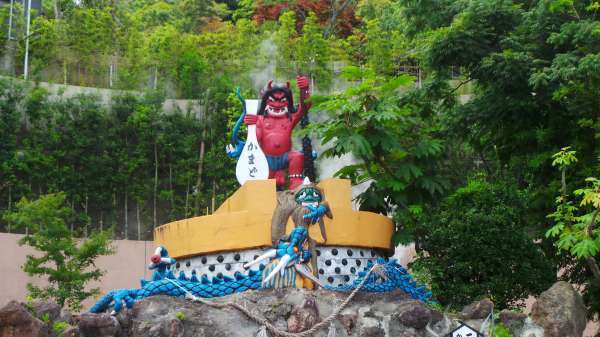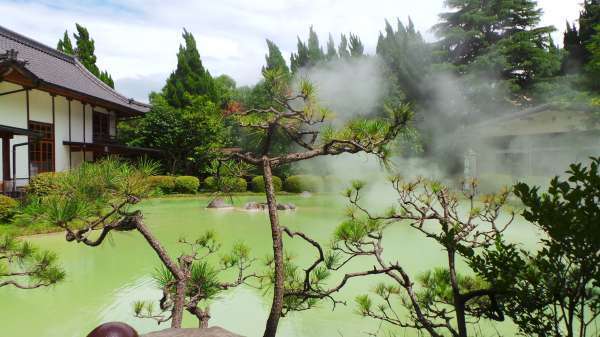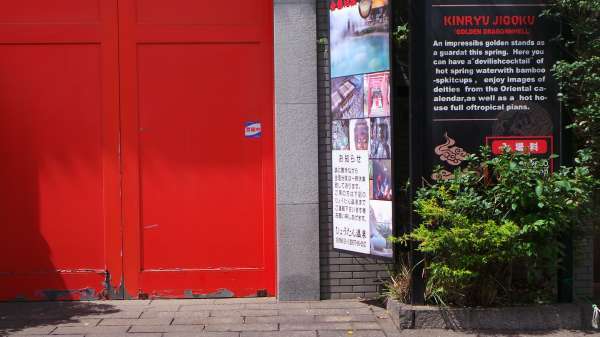In Beppu, there is an area known as the Hells, a place feauturing eight connected outdoor springs each with their own theme. Crocodile Hell, Oven Hell, and Bloody Hell are amongst the highlights, so read on as I guide you through the Hells of Beppu:
Today I leave from Beppu Station by bicycle, and head in the direction of Hell. After cycling uphill for almost an hour, I arrive at Kannawa Hyotan Onsen. Hot spring baths are everywhere in Beppu. Plumes of white smoke rise up in almost every direction. Even the cold water here comes out of the tap hot. I use the free outdoor foot onsen at the entrance and relax for a while before heading even further uphill.
I finally arrive in an area called “The Hells.” I pay ¥400 and enter one of ‘The Hells’. Oniyama Jigoku, or Crocodile Hell. A sign inside says: “The force of the steam is so strong here that about one and a half train cars can be pulled by its pressure, and it creates ideal conditions for breeding crocodiles.” The sign is next to a really hot stream of spring water. The temperature, the sign says, is 99°C.

When the spring water cools in the winter, they put the crocodiles inside to breed. I wander around. The crocodiles are quite scary and there are lots of them. We stare at crocodiles for a long while. They do not move. They do not even blink. Playing dead a specialty of theirs. I find some enclosures with water and a few crocodiles swimming around.
After Crocodile Hell, I decide to cycle further, instantly regretting it the moment my foot hits the pedal. Next stop Kamado Jigoku, or Oven Hell. I pay my ¥400 entry fee. Inside, there is a statue of a great red demon standing on an enormous cooking pot. A long time ago they would cook using the 100°C steam. This is what the statue represents.

Also at Oven Hell there are many different stoves heating very old metal kettles. There is also a pond that, “Changes colour a couple of times a year.” There are loads of pools of bubbling mud. If you blow something that burns and smokes into the mud, it causes the amount of steam to intensify. This is demonstrated by a staff member with an unnecessary megaphone and a cigarette. After touring the many pools I am given the opportunity to eat an egg boiled in the steam of Oven Hell.
After Oven Hell I head for Umi Jigoku, Sea Hell. An explosion from a volcano 1,200 years ago created a pond of boiling water. For some unexplained reason, the pond is cobalt blue. This place shouldn’t really be described as a Hell. The area is full of natural beauty. There are no gimmicks here. No eggs here. No crocodiles. Just wildlife and scenery.

Sea Hell is massive. In random ponds float tropical water lilies, bananas grow inside a building labelled, “Hell emitting gas use greenhouse,” and random waterfalls and hot springs are surrounded by nature. Inside the gift shop the air conditioning is so cold. I stay here pretending to look at tacky souvenirs, while I secretly cool off from the heat of a hot summers day.
Shiraike Jigoku, White Pond Hell, is the next Hell I visit. I pay my ¥400 entry fee and admire the white pond. The water apparently is, “Transparent but as time passes it turns a blue-white colour.” I have no idea why the sign says this; the pond water is clearly green. Also at White Pond Hell, there is a really old aquarium with just three fish.

Opposite Shiraike Jigoku is a closed red door. The sign next to the door says Hinryu Jigoku, Golden Dragon Hell. Inside this Hell is a, “Dragon statue with steam coming through its mouth that seems to be flying when water spouts out at sunrise.” I really enjoy the impressibs description on the sign:

The next two Hells I plan to visit today are half way down the mountain and about ten minutes away. I get back on my bicycle and take a very fun bike ride down the winding mountain path, through the many forests and tunnels carved into the mountainside.
Chinoike Jigoku translates to the amusing, ‘Bloody Hell’. Here there is a massive pool of red hot mud estimated to have been here for over 1300 years. This is Japan’s oldest natural hot spring. It takes its name from the image of Hell found in Buddhism. There is also a nice waterfall here. Some colourful Koi Carp fish swim in the pool below.

After Bloody Hell, I head next door to Tatsumaki Jigoku, Spout Hell, but sadly, it closes at 5 p.m. It is possible to visit all eight Hells in one day, however, I spent far too much time looking at crocodiles that I failed. There is also a special discounted ticket ¥2100, which includes entry to all of the Hells, a great option if you are planning on visiting at least six of the eight in one day.
Find out more about Beppu Hells from Planetyze
My post about the best things to do in Oita
My post about the best things to do in Beppu
TripAdvisor guide to the top Beppu attractions
Reviews from TripAdvisor about Beppu Hells
Tours of Oita and Beppu